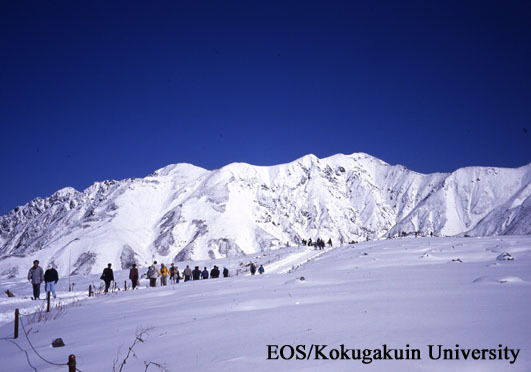- トップ
- Encyclopedia of Shinto
- Tateyama Shinkō
Encyclopedia of Shinto
| Main Menu: | |
| Links: |
詳細表示 (Complete Article)
| カテゴリー1: | 6. Belief and Practice |
|---|---|
| カテゴリー2: | Mountain Beliefs and Practices |
| Title | Tateyama Shinkō |
| Text | Beliefs and practices surrounding Tateyama, the composite name given to a series of peaks found in Toyama Prefecture, the highest of which is Ōnanjiyama (3015 m.). Along with Hakusan it was an important Shugendō site and sacred mountain in the central western coastal region. The main peak is Oyama, whose kami, Oyama no kami, is mentioned in the Manyōshū; this deity is also known as Tateyama no kami and Tateyama Gongen. According to the Ruiju kigenshō (late Kamakura period), its founder was an unknown hunter. Later legendary histories and the picture scroll known as the Tateyama Mandara say that Ariyori, a nephew of Saeki Ariwaka, the administrator of Etchū Province (present-day Toyama Prefecture), borrowed his father's white hawk and went hunting in the mountains. There he shot a bear, which changed into Amida. Ariyori received the Buddhist precepts and the religious name of Jikō. The original Buddhist form (honji) of Tateyama Gongen was Amida, and under the influence of Pure Land beliefs, there was a strong idea that the mountain was Amida's Pure Land of Sukhavati. There was also a cult attached to the area around Jigokudani ("Hell Valley"); the forbidding landscape was dotted with pools of boiling mud which were thought to represent hell, while volcanic pools were regarded specifically as the Pool of Blood Hell, and it was here that wrongdoers were said to go after death. The Hokke genki (by Chingen, 1040-43) and the Konjaku monogatari (late Heian period) contain tales of women who fell into hell at Tateyama and who attained salvation when their parents copied out sutras. Beliefs in hell and paradise were probably spread by shugen practitioners, hijiri and bikuni (female itinerant religious figures). In the Edo period, Tateyama was made up of seven shrines and 24 temples, of which the most important were the Kamimiya on the summit of Oyama, the middle shrine at Ashikuraji, and the outer shrine and front building at Iwakuraji. Ashikuraji and Iwakuraji, which stand on the Jōganji River, flowing down from Tateyama, were the two main Shugendō centers. Shugen priests from here ran pilgrims' lodgings, guided pilgrims to Tateyama (Tateyama chūgo) and climbed the sacred peaks (Tateyama zenjō). During this time Iwakuraji had more than twenty shugen subtemples and supervised the greater part of the area of Tateyama. It extracted fees from pilgrims to stay at the Murodō and to climb the mountain (yamayakusen). When buildings were to be repaired or reconstructed, shugen priests would conduct canvassing campaigns in nearby provinces, centering on touring holy images. Ashikuraji had around 30 subtemples, of which the Ubadō and the Enmadō were the most important. Parishioners were acquired throughout the country and the Tateyama cult was spread mainly through canvassing campaigns. Confraternities (kō) were established in the parishes (dannaba) and every year the protective talismans of the gongen would be distributed there and those members who would next make pilgrimage to the mountain decided. Copies of the Menstruation Sutra (Ketsubonkyō) were also distributed, as a means of female salvation, as were various medicines such as the Tateyama gentian (rindō), yunokusa, kumanoi and wild carrot, all remedies for stomach complaints. This is considered to have been the origin of the famous Toyama medicine peddlers. Shugen priests would also take with them on their parish visitations copies of the Tateyama Mandara and explain through them the sufferings of the hells and the nature of the gongen's saving powers. Mandara in the Ashikuraji tradition emphasized the rite called the Nunohashi Consecration which took place at the Ubadō and the Enmadō. Here, at the time of the autumn equinox, a white cloth (nuno) was spread over the bridge connecting these two halls; hence the bridge was known as Nunohashi ("cloth bridge"), and also as the Bridge of Heaven. It was only at this one time in the year, on the middle day of the autumn equinox, that women were allowed to enter the precincts, normally forbidden them, as far as the Ubadō, from where, having received the protection of the deity Ubagami, they worshipped the sacred mountain and prayed for rebirth in paradise. The rite was an enactment of death and rebirth. After the rite, pieces of the white cloth that had been spread over the bridge were distributed among believers as burial shrouds. Until the separation of buddhas and kami (shinbutsu bunri) in the early Meiji period, the main image of the Ubadō was an Uba (kami in the form of an old woman) triad and there were also 66 Uba statues, each representing one of the 66 provinces of Japan. They retained features of the kami of the mountains (yama no kami). Thus, though Tateyama was closed to women and place names in the area, such as Ubaishi ("old woman's stone"), Bijosugi ("cedar of the beautiful woman") and Kamurosugi ("maiden's cedar"), recall legends related to this taboo, it also fostered a belief in female salvation. After the separation of buddhas and kami, Iwakuraji became Oyama Shrine, and Ashikuraji became an auxiliary shrine called Ōmiya Wakamiya. Shugendō was abolished. — Suzuki Masataka |




